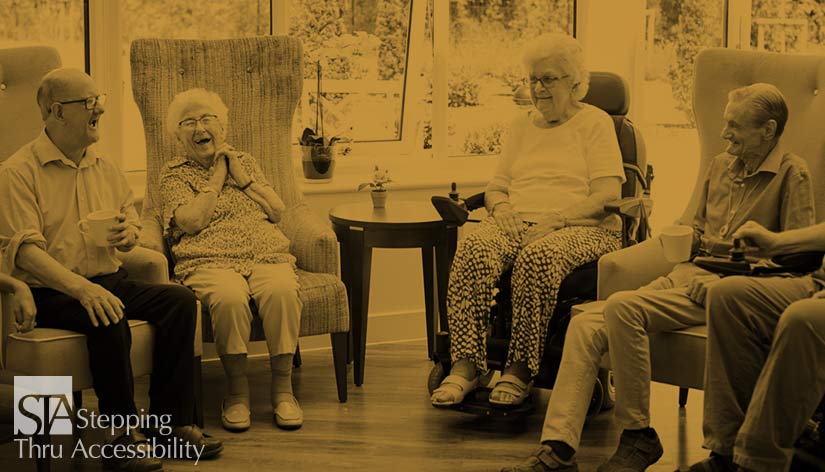Blog
Return to Blog »
Janis Kent, FAIA Architect, CASp © March, 2019; modified June 2021 I have received a number of questions on how to treat multi-family residential facilities that also have offices and other services, and whether these are considered mixed-use facilities. And of course the answer is – it depends. There is a category under the ADA Standards that is often missed and is becoming much more prevalent for supportive housing – social service center establishments. The ADA Standards define it as; Group homes, halfway houses, shelters, or similar social service center establishments that provide either temporary sleeping accommodations or residential dwelling units that are subject to this section shall comply with the provisions of the 2010 Standards applicable to residential facilities, including, but not limited to, the provisions in sections 233 and 809 (pp. 91 and 212). Many get stuck at the first portion of the definition of “…group homes, halfway houses, shelters…” and do not look further at the following portion of the definition “…or similar…that provide either temporary sleeping accommodations or residential dwelling units…”. And the question comes up of – what does this actually mean. Some examples are, transitional living centers, emergency shelters, special needs housing, some senior housing, and other facilities that provide a significant level of social services along with living accommodations. Living accommodations can be anything from dorm rooms with multi-beds, to individual bedrooms with shared facilities, to dwelling units, and can be temporary or permanent. The services can include counseling, education and training, transportation, assistance with daily living activities, providing meals, or recreational activities. Provision of just one type of service does not necessarily mean the facility is a social service center establishment but rather provision of a ‘significant level’ of services. A ‘significant level’ is not defined, but it is a balance of the nature, the level, and the amount of services provided. So there is a judgement call here. I have seen some housing facilities that provide counseling, education, job skill training, child care, fitness classes, and even some with medical or therapeutic support for their residents. Many times this is in support of getting families back on their feet and into the work environment. Or it can be for homeless youth to assist them back into education and self- sufficiency. Or for battered women and their children for safety and support for independence. Other programs can be transitions from institutions, or from homelessness. If the facility falls into any of these categories, you would follow the residential requirements under the ADA Standards (233, 809, and other ADA requirements as applicable) regardless of funding sources, whether public or private. And this is as modified by the ADA implementing regulations under either § 35.151(e) if public funding or a program of a public entity, or § 36.406 (d) if privately funded. There are further requirements to follow as well. If there are sleeping rooms with more than 25 beds in a room, 5% of the beds are to have a clear floor space on both sides of the bed of 36” x 48” or a single clear floor space can be shared between two beds. If the facility has more than 50 beds total and presuming there are common bathing facilities, then a roll-in or alternate roll-in shower is to be provided with grab bars and a shower seat installed. If there are gender-specific shower rooms, then provide the same shower facilities for each gender. If there is a common space kitchen, a work surface is not required and the sink is provided with no cabinetry below, removable or otherwise. The residential space, whether a dwelling unit for a single family or a shared dwelling unit, follow the requirements for dwelling units and will need to meet the 5% mobility and 2% communication feature requirements. You might also need to meet the FHA Guidelines with a selected safe harbor if it falls under the requirements of a covered facility. The common spaces and social service center areas will need to meet the ADA Standards requirements. If your project is in California, the CBC had placed the requirements under transient lodging and stated to also follow residential requirements, but does not tell you how to do this. This has now been corrected, since if you had followed transient lodging requirements for scoping, you would not meet the ADA requirements. For instance, if you had 50 sleeping rooms under transient lodging you would have been required to provide 2 mobility feature rooms, whereas under residential you would be required to provide 3. Other items are doorbells – under transient lodging just visual notification is required, whereas residential requires visible and audible. Kitchens also have lesser requirements under transient lodging. But this has now been addressed in the CBC, and any existing projects built erroneously under the incorrect category should be corrected to meet ADA requirements. Previously, the Department of Justice had social service establishment under transient lodging and with the 2010 ADA Standards changed it to a new designation for either temporary sleeping accommodations or residential dwelling units placing it under residential with some modifications. How and when to implement these requirements do not appear to be well defined, but rather a judgement call is necessary of how many social services triggers the facility into a social service center establishment with residential dwelling unist. So be aware of this type of facility and consider the types and quantities of services being offered before you proceed with design. Be aware that your local City or County may have additional requirements that are more restrictive than the State or Federal requirements. Also, this article is an interpretation and opinion of the writer. It is meant as a summary – current original regulations should always be reviewed when making any decisions. © Janis Kent, Architect, FAIA, CASp March, 2019Social Service Center Establishments – What Are They?
